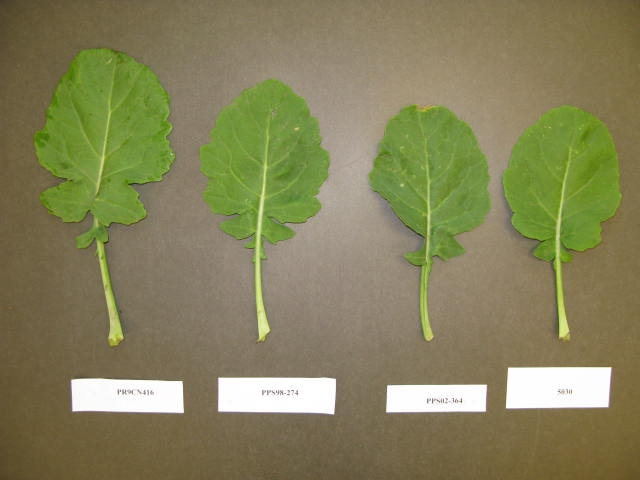PR9CN416
| Denomination: | 'PR9CN416' |
|---|---|
| Botanical Name: | Brassica napus |
| Applicant/Holder: |
BASF Agricultural Solutions Seed US LLC 100 Park Avenue Florham Park, New Jersey 07932 United States of America |
| Breeder: |
Stewart Brandt, Bayer CropScience Inc., Saskatoon, Saskatchewan |
| Agent in Canada: |
BASF Canada Inc. Site 600, Box 117 RR#6 Saskatoon, Saskatchewan S7K 3J9 Canada Tel: 306-371-6226 |
| Application Date: | 2010-07-08(priority claimed) |
| Application Number: | 10-7036 |
| Protective direction granted: | 2010-07-08 |
| Grant of Rights Date: | 2012-05-09 |
| Certificate Number: | 4308 |
| Exemption from compulsory licensing: | Yes |
| Expiry date for exemption from compulsory licensing: | 2014-05-09 |
| Grant of Rights Termination Date: | 2030-05-09 |
Variety Description
Varieties used for comparison: 'PPS98-274', 'PPS02-364' and '5030'
Summary: 'PR9CN416' flowers earlier than 'PPS98-274'. The silique of 'PR9CN416' is shorter than 'PPS98-274' and 'PPS02-364'. 'PR9CN416' has a longer beak than '5030'. The pedicel of 'PR9CN416' is longer than 'PPS02-364' and '5030'. 'PR9CN416' has a shorter plant height at maturity than 'PPS98-274' and '5030'.
Description:
PLANT: male fertile restorer line, spring seasonal type, short height at maturity
COTYLEDON: medium to wide, medium to long
LEAF: medium green, few to medium number of lobes, rounded to sharp margin, low density of shallow dentations, medium to long, medium to wide, long petiole
FLOWER PETALS: yellow, medium length, narrow to medium width
SILIQUE: semi-erect attitude, medium length, long to very long beak, long to very long pedicel
SEED: black
AGRONOMIC CHARACTERISTICS: fair resistance to lodging
QUALITY CHARACTERISTICS: erucic acid is 0.05% of total fatty acids, oil content is 48.34% of whole dried seed, protein is 23.55% of dried oil free meal, very low glucosinolates (9.86 µmol/g)
DISEASE RESISTANCE: resistant to Blackleg (Leptosphaeria maculans asexual stage: Phoma lingam) and resistant to White Rust (Albugo candida, races 7a & 2v)
Origin & Breeding History: 'PR9CN416' is a restorer inbred line used in F1 hybrid production, that contains the Rf3 gene construct in homozygous state. 'PR9CN416' is a doubled haploid line that was produced in Canada in 2007. It was selected in 2008 on the basis of fertility restoration of numerous male sterile lines and expression of tolerance to glufosinate ammonium herbicide. Other selection criteria included height, vigour, maturity, blackleg resistance, oil content, fatty acid profile, glucosinolate content and combining ability.
Tests & Trials: Trials were conducted in Saskatoon, Saskatchewan during the summers of 2009 and 2010. In 2009, the trial was set up with 3 replicates arranged in a RCB design. In 2010, the trial setup was 3 replicates arranged in Lattice design. Each year the plots consisted of 3 rows with a row length of 6 metres and a row spacing of 50 cm.
Comparison tables for 'PR9CN416' with reference varieties 'PPS98-274', 'PPS02-364' and '5030'
Days to flowering
| 'PR9CN416' | 'PPS98-274' | 'PPS02-364' | '5030' | |
|---|---|---|---|---|
| mean (LSD=3.3) | 42.1 | 45.5 | 41.0 | 43.0 |
Silique length (mm)
| 'PR9CN416' | 'PPS98-274' | 'PPS02-364' | '5030' | |
|---|---|---|---|---|
| mean (LSD=5.4) | 56.1 | 68.0 | 62.0 | 59.8 |
| std. deviation | 5.9 | 5.4 | 6.0 | 5.3 |
Beak length (mm)
| 'PR9CN416' | 'PPS98-274' | 'PPS02-364' | '5030' | |
|---|---|---|---|---|
| mean (LSD=3.7) | 15.8 | 13.3 | 13.0 | 9.7 |
| std. deviation | 2.0 | 1.7 | 1.7 | 1.8 |
Pedicel length (mm)
| 'PR9CN416' | 'PPS98-274' | 'PPS02-364' | '5030' | |
|---|---|---|---|---|
| mean (LSD=2.61) | 23.9 | 23.3 | 17.4 | 19.4 |
| std. deviation | 4.0 | 2.5 | 2.4 | 3.0 |
Plant height at maturity (cm)
| 'PR9CN416' | 'PPS98-274' | 'PPS02-364' | '5030' | |
|---|---|---|---|---|
| mean (LSD=19) | 112 | 139 | 123 | 142 |
| std. deviation | 8.1 | 9.0 | 8.0 | 10.4 |
Click on image for larger view

Canola: 'PR9CN416' (left) with reference varieties 'PPS98-274' (centre left), 'PPS02-364' (centre right) and '5030' (right)
- Date modified: